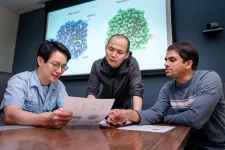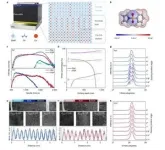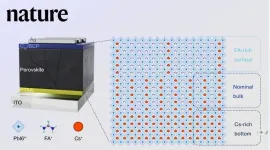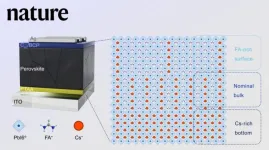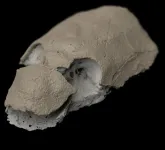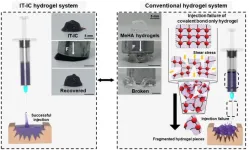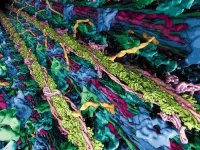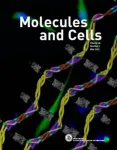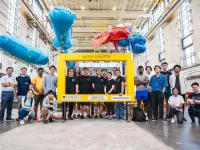(Press-News.org) (Memphis, Tenn – November 1, 2023) Neurons talk to each other using chemical signals called neurotransmitters. Scientists at St. Jude Children’s Research Hospital have drawn on structural biology expertise to determine structures of vesicular monoamine transporter 2 (VMAT2), a key component of neuronal communication. By visualizing VMAT2 in different states, scientists now better understand how it functions and how the different shapes the protein takes influence drug binding — critical information for drug development to treat hyperkinetic (excess movement) disorders such as Tourette syndrome. The work was published today in Nature.
How our neurons talk to each other
Chemical compounds called monoamines, which include dopamine, serotonin and adrenaline, play a central role in neuronal communication. These molecules affect how the brain works, controlling our emotions, sleep, movement, breathing, circulation and many other functions. Monoamines are neurotransmitters (signaling molecules) produced and released by neurons, but before they can be released, they must first be packaged into vesicles.
Vesicles are cellular compartments that store neurotransmitters before they are released at the synapses (the junction through which chemical signals pass from one neuron to another). Think of vesicles as the cargo ships of the neuronal cell — neurochemicals are packed inside them and taken to where they need to go. VMATs are proteins on the membrane of these vesicles that move monoamines into the space within, acting like loading cranes for the cargo ships.
“VMATs are transporters that are required for packing these monoamine neurotransmitters into synaptic vesicles,” explained co-corresponding author Chia-Hsueh Lee, Ph.D., St. Jude Department of Structural Biology.
Once the VMAT has packed the vesicle with monoamines, the “cargo ship” moves towards the synaptic gap (the space between neurons), where it releases the chemical compounds.
The many faces of monoamine transporters
There are two types of VMAT: VMAT1 and VMAT2. VMAT1 is more specialized, found only in neuroendocrine cells, whereas VMAT2 is found throughout the neuronal system and has significant clinical relevance.
“We knew that VMAT2 is physiologically very important,” Lee said. “This transporter is a target for pharmacologically relevant drugs used in the treatment of hyperkinetic disorders such as chorea and Tourette Syndrome.”
Despite their importance, the structure of VMAT2, which would allow researchers to investigate how it works fully, had remained elusive. Lee and his team used cryo-electron microscopy (cryo-EM) to obtain structures of VMAT2 bound to the monoamine serotonin and the drugs tetrabenazine and reserpine, which are used to treat chorea and hypertension, respectively. This was no easy feat.
“VMAT2 is a small membrane protein,” explained co-first author Yaxin Dai, PhD., St. Jude Department of Structural Biology. “This makes it a very challenging target for cryo-EM structure determination.”
Despite the difficulty and using some clever tricks, the team captured multiple structures of VMAT2 that allowed them to tease out how the protein functions and investigate how exactly those drugs work. “VMAT transporters adopt multiple conformations [shapes] while transporting their substrate. This is called alternating access transport, where the protein is either “outward” or “inward” facing,” explained co-first author Shabareesh Pidathala, Ph.D., St. Jude Department of Structural Biology. “To completely gain mechanistic understanding at an atomic level, we needed to capture multiple conformations of this transporter.”
Answering a 40-year-old question
The researchers discovered this dynamic mechanism means multiple opportunities for drugs to bind. They confirmed that reserpine and tetrabenazine bind two different conformations of VMAT2. “30 or 40 years of pharmacological research had suggested that these two drugs bind to the transporter in different ways,” said Pidathala, “but nobody knew the atomic details of how this works. Our structures nicely demonstrate that these two drugs stabilize two different conformations of the transporter to block its activity.”
The structure of VMAT2 with serotonin bound allowed the researchers to pinpoint specific amino acids that interact with the neurotransmitter and drive transport. “We believe this is a common mechanism that this transporter uses to engage all the monoamines,” said Lee.
While this work offers a huge leap forward in understanding monoamine transport, Lee and his team are delving deeper into its mechanism. For example, the intake of monoamines into vesicles is fueled by protons moving in the other direction. “We identified amino acids that are important for this proton-dependent process,” Lee said, “but we still don’t know how exactly protons drive this transport. Determining this mechanism is our future direction, which will help us to fully appreciate how this transporter works.”
Authors and funding
The study’s other first author is Shuyun Liao of the School of Life Sciences, Peking University. The study’s co-corresponding author is Zhe Zhang of the School of Life Sciences, Peking University. Other authors include Xiao Li and Chi-Lun Chang of St. Jude, and Changkun Long of the School of Life Sciences, Peking University.
The study was supported by grants from National Institutes of Health (R01GM143282), the National Key Research and Development Program of China (2021YFA1302300), the National Natural Science Foundation of China (32171201), the SLS-Qidong innovation fund, the Li Ge-Zhao Ning Life Science Youth Research Foundation, the State Key Laboratory of Membrane Biology of China, and ALSAC, the fundraising and awareness organization of St. Jude.
St. Jude Media Relations Contacts
Chelsea Bryant
Desk: (901) 595-0564
Cell: (256) 244-2048
chelsea.bryant@stjude.org
media@stjude.org
Rae Lyn Rushing
Desk: (901) 595-4419
Cell: (901) 686-2597
Raelyn.rushing@stjude.org
media@stjude.org
St. Jude Children's Research Hospital
St. Jude Children's Research Hospital is leading the way the world understands, treats and cures childhood cancer, sickle cell disease and other life-threatening disorders. It is the only National Cancer Institute-designated Comprehensive Cancer Center devoted solely to children. Treatments developed at St. Jude have helped push the overall childhood cancer survival rate from 20% to 80% since the hospital opened more than 60 years ago. St. Jude shares the breakthroughs it makes to help doctors and researchers at local hospitals and cancer centers around the world improve the quality of treatment and care for even more children. To learn more, visit stjude.org, read St. Jude Progress blog, and follow St. Jude on social media at @stjuderesearch.
END
Scientists reveal structures of neurotransmitter transporter
2023-11-01
ELSE PRESS RELEASES FROM THIS DATE:
Heterogeneity of Earth’s mantle may be relics of Moon formation
2023-11-01
An interdisciplinary international research team has recently discovered that a massive anomaly deep within the Earth’s interior may be a remnant of the collision about 4.5 billion years ago that formed the Moon.
This research offers important new insights not only into Earth’s internal structure but also its long-term evolution and the formation of the inner solar system.
The study, which relied on computational fluid dynamics methods pioneered by Prof. DENG Hongping of the Shanghai Astronomical Observatory (SHAO) of ...
Study reveals location of starfish’s head
2023-11-01
If you put a hat on a starfish, where would you put it? On the center of the starfish? Or on the point of an arm and, if so, which one? The question is silly, but it gets at serious questions in the fields of zoology and developmental biology that have perplexed veteran scientists and schoolchildren in introductory biology classes alike: Where is the head on a starfish? And how does their body layout relate to ours?
Now, a new Stanford study that used genetic and molecular tools to map out the body regions of starfish – by creating a 3D atlas of their gene ...
Scientists propose perovskite films homogenizing strategy to increase conversion efficiency
2023-11-01
In a study published in Nature, researchers from the Hefei Institutes of Physical Science (HFIPS) of the Chinese Academy of Sciences have proposed a new and promising method of fabricating homogenized perovskite films for solar cells. The process involves inhibiting phase segregation caused by internal cation inhomogeneity to increase conversion efficiency to 26.1%, thus tying the existing record.
Their work was also featured as a Nature Editor’s Pick.
For solar cells, an important alternative energy ...
Scientists propose perovskite film homogenizing strategy to increase conversion efficiency
2023-11-01
In a study published in Nature, researchers from the Hefei Institutes of Physical Science (HFIPS) of the Chinese Academy of Sciences have proposed a new and promising method of fabricating homogenized perovskite films for solar cells. The process involves inhibiting phase segregation caused by internal cation inhomogeneity to increase conversion efficiency to 26.1%, thus tying the existing record.
Their work was also featured as a Nature Editor's Pick.
For solar cells, an important alternative energy source, the pursuit of higher conversion efficiency and the attempt to keep the cells table as long as possible are core issues that scientists and engineers all over the world are ...
How the fish got its shoulder
2023-11-01
A new analysis of the bones and muscles in ancient fish gives new clues about how the shoulder evolved in animals – including us.
The shoulder girdle – the configuration of bones and muscles that in humans support the movement of the arms – is a classic example of an evolutionary ‘novelty’. This is where a new anatomical feature appears without any obvious precursors; where there is no smoking gun of which feature clearly led to another.
The new research, which draws together a range of evolutionary investigation techniques including fossils, ...
New “injectable tissue prosthesis coupled with closed-loop bioelectronic system” to aid in damaged muscle/nerve regeneration and robot-assisted rehabilitation
2023-11-01
In a recent publication in the journal Nature, researchers from the Institute of Basic Science (IBS) in South Korea have made significant strides in biomaterial technology and rehabilitation medicine. They've developed a novel approach to healing muscle injury by employing “injectable tissue prosthesis” in the form of conductive hydrogels and combining it with a robot-assisted rehabilitation system.
Let’s imagine you are swimming in the ocean. A giant shark approaches and bites a huge ...
Breakthrough discovery sheds light on heart and muscle health
2023-11-01
Atrial fibrillation, heart failure and stroke – hypertrophic cardiomyopathy can lead to many serious health conditions and is a major cause of sudden cardiac death in people younger than 35. „The heart muscle is a central engine of the human body. Of course, it is easier to fix a broken engine, if you know how it is built and how it functions”, says Stefan Raunser. “At the beginning of our muscle research we have successfully visualized the structure of the essential muscle building blocks and how they interact using electron cryo-microscopy. However, these were static images of proteins taken out of the living cell. They only tell us little ...
Chemical process makes peptide acquire structure similar to amyloid plaques found in neurodegenerative diseases
2023-11-01
Peptides are biomolecules formed when two or more amino acids that perform key functions in the human organism, such as hormones, neurotransmitters, painkillers and antibiotics, bind together. For this reason, they are much studied and used by the pharmaceutical industry, for example.
A study conducted by scientists in the Department of Biophysics at the Federal University of São Paulo's Medical School (EPM-UNIFESP) in Brazil identified significant changes in the physicochemical properties of peptides during a spontaneous process of chemical change called pyroglutamination.
Pyroglutamination is a modification resulting from spontaneous conversion ...
Elsevier partners with the Korean Society for Molecular and Cellular Biology to publish Molecules and Cells
2023-11-01
Amsterdam, November 1, 2023 – The Korean Society for Molecular and Cellular Biology (KSMCB), one of the largest and most prominent academic societies in the field of life sciences in Korea, and Elsevier, a leader in information and analytics for customers across the global research and health ecosystems, are pleased to announce a new partnership to publish Molecules and Cells, the flagship journal of KSMCB. This English-language publication will be hosted on Elsevier’s industry-leading online platform of peer-reviewed literature, ScienceDirect, beginning January 1, 2024. Continuing ...
Do physical connections improve the control and performance of robot swarms?
2023-11-01
In nature, swarms can accomplish amazing things. Schools of fish can more efficiently find food and migrate. Flocks of birds can confuse predators. Bees, ants, and termites can work together to feed, defend and build their colonies.
Robotics researchers have long been trying to harness this ability to explore environments, capture objects and build structures using robot swarms.
“But the problem of how do we efficiently control all those robots is still unsolved,” says David Saldaña, an assistant professor ...
